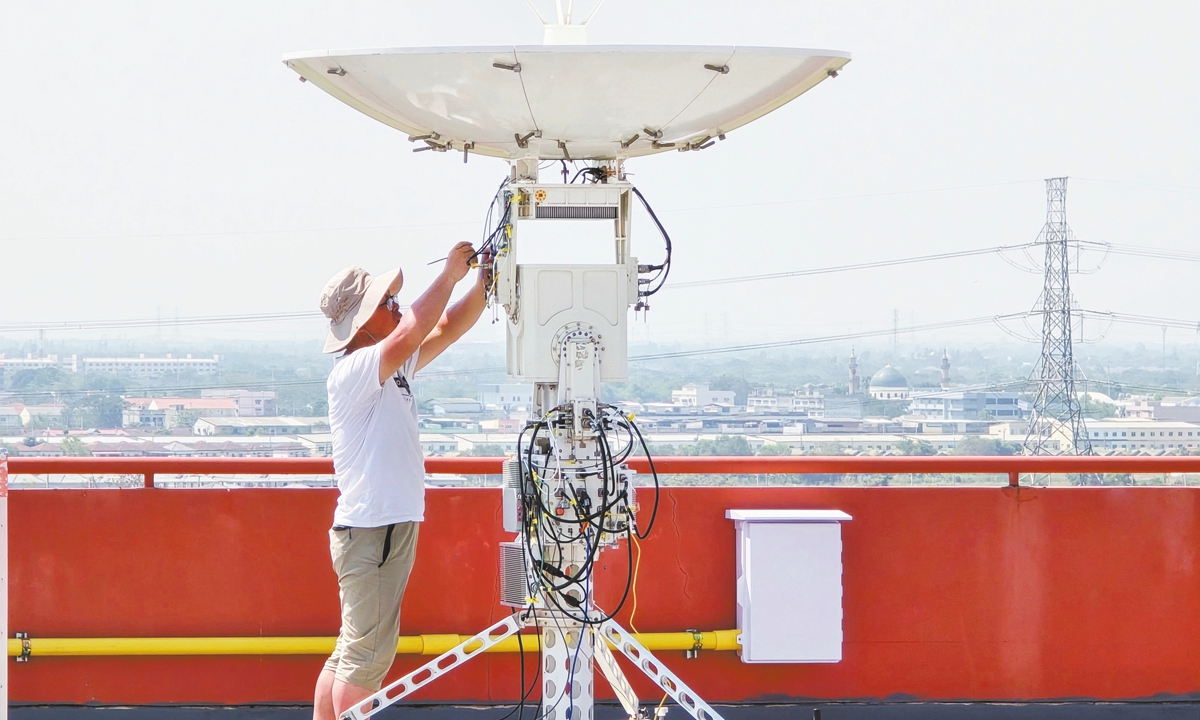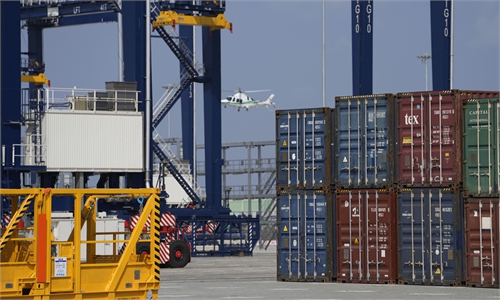Joint labs feature thriving BRI tech cooperation
Promising prospects seen in LEO satellite internet collaboration: insider

A technician from Galaxy Space checks satellite antenna at the Mahanakorn University of Technology, Thailand, on March 6, 2024. Photo: Courtesy of Galaxy Space
Zhang Yonghe, vice president of the Innovation Academy for Microsatellites of Chinese Academy of Sciences (IAMC), can easily recall the inauguration of the China-Portugal STARLab in 2021. The STARLab is a joint laboratory established under the Belt and Road Initiative (BRI), aiming to integrate China's leading space technology with Portugal's strengths in marine research to foster interdisciplinary cooperation.
To date, research teams from China and Portugal have launched a number of cooperation projects through data sharing and joint research, covering fields such as remote sensing data analysis and marine observation technology, according to Zhang.
"Future cooperation between the two sides will delve deeper into areas such as the joint design and development of complex system equipment," Zhang told the Global Times. He stressed that this joint lab model, while building a space bridge for scientific and technological cooperation along BRI partner countries, has also allowed individual participants to fully leverage their advantages, generating an effect of "one plus one greater than two."
In the case of STARLab, Portugal is rich in marine resources, while IAMC has launched over 50 satellites in the past five years, showcasing its capability to develop and launch satellites weighing from kilograms to tons. This cooperation enables both sides to leverage their complementary innovative resources to conduct multi-dimensional multi-source data scientific research.
STARLab is one of over 50 joint laboratories that China has built with BRI partners in recent years, all serving as vivid testaments to the thriving scientific and technological cooperation under BRI. China has also signed intergovernmental scientific and technological cooperation agreements with more than 80 BRI partner countries. Industry insiders said that the BRI technological cooperation, championed by joint labs, has "created a tight innovation chain from concept to engineering" and has demonstrated greater flexibility and openness in technological cooperation.
China also vowed last year to increase the number of joint laboratories to 100 within the next five years. Through strengthened technological and innovation collaboration, observers said that this new paradigm of cooperation will enhance the endogenous development drives of BRI participating countries, create new strategic opportunities for emerging global markets and enable developing countries to play a greater role in global governance.
New paradigm of cooperation
Compared to traditional flagship international cooperation projects, which often take more than 10 years to complete, this new paradigm firstly advances proof-of-concept studies to attract more participants and then gradually increases investment to eventually achieve a common goal. "In terms of international technological cooperation, it is easier to break down technological barriers and attract more international partners," Zhang explained.
"We are still exploring new paradigms for future cooperative missions, such as the Chasing All Transients Constellation Hunters, an astronomical microsatellite constellation for burst follow-up observations," Zhang said.

Zhang Yonghe, vice president of IAMC Photo: Courtesy of IAMC
According to Zhang, IAMC has also established cooperation with a number of BRI partners and other countries in recent years. In June, the Space-based Variable Objects Monitor (SVOM), the first astronomy satellite jointly developed by China and France, was successfully launched from China's Xichang Satellite Launch Center, marking a milestone in China-France satellite building cooperation.
Solar wind Magnetosphere Ionosphere Link Explorer (SMILE), the first joint satellite mission between the European Space Agency and the Chinese Academy of Science, has entered its test period. SMILE is planned to be launched in two years from Europe's spaceport in Kourou, French Guiana.
In December 2023, China launched a remote-sensing satellite for Egypt, marking a new milestone in the two nation's space cooperation under BRI. And thanks to the MisrSat 2 project, Egypt has become the first African country capable of assembling, integrating and testing satellites.
Greater potential in satellite technologies
Industry insiders are optimistic about the prospects of satellite technology cooperation among BRI partners, especially in the construction of low-earth orbit (LEO) broadband satellite internet.
Regarding China's satellite technology, Zhang said that the country will see an "explosive" number of satellite launches in the coming years. "It is also important to note the cost-effectiveness of [China-developed] microsatellites, which means that they're easier to enter mass production and can be launched in bulk. This gives them a natural advantage in building vast internet networks made up of thousands of satellites in space," Zhang noted.
In May, the private Chinese aerospace company Galaxy Space conducted test verification of a low-orbit satellite internet broadband communication network in Thailand in collaboration with Thailand's Mahanakorn University of Technology.
Huang Heping, general manager of International Business at Galaxy Space, told the Global Times on Thursday that the test marks the first overseas application of China's LOE broadband satellite internet.
"It's a win-win cooperation, as Chinese companies have developed the capacity for low-cost mass production of satellites and have built rich expertise in the construction of satellite internet.
For Thailand, with its vast seas and extensive coastline, the development of satellite internet could provide communication support for the country's fisheries, maritime transport, and other blue economy sectors, as well as its tourism industry," Huang explained.
Huang added that this cooperation will also drive the growth of related upstream and downstream industries in Thailand, including satellite manufacturing and network operations.
Observers noted that in the next phase of BRI technological cooperation, it is important for Chinese tech companies to help build a high-tech industrial chain that synergizes with regional innovation systems and aligns with them, fostering new growth in the local economy.
"Through resource sharing and capacity building, developing countries could create a new governance model that challenges Western dominance in the tech sector," Li Yangyang, a research assistant at the Institute of International Scientific and Technological Relations under the Chinese Academy of Science and Technology for Development, told the Global Times.




